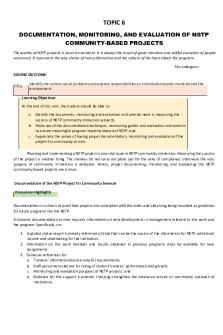Topic 6 - PDF

| Title | Topic 6 - |
|---|---|
| Author | Kelsey Berg |
| Course | Mathematics for Elementary Teachers II |
| Institution | Grand Canyon University |
| Pages | 1 |
| File Size | 64.6 KB |
| File Type | |
| Total Downloads | 18 |
| Total Views | 142 |
Summary
...
Description
Kelsey Berg MAT 151 Carolyn Horner Topic 6 DQ 1 What is a geoboard? How can a geoboard be used to develop geometric concepts? Give some examples of how you might use a geoboard. Is this practical to use in a classroom? Explain your answer. A geoboard is a manipulative used to explore basic concepts in plane geometry such as the perimeter, area, and other characteristics of triangles and polygons. It is a board with pegs in which you use rubber-bands to create triangles and polygons, in which you can then find measurements of the shapes on the plane. I would teach students about similarity of triangles and polygons while using a geoboard. I would have students make the same shapes, but one larger than the other and determine the scale factor that makes them different size but same shape. I do think this is a practical manipulative to use in the classroom, especially for students that learn by doing hands-on examples and projects. Provide multiple sources for learning that fit each child’s learning needs will create and effective and successful learning environment for all the students. DQ 2 What is the Pythagorean theorem? Explain how the Pythagorean theorem may be proven using squares. How can the Pythagorean theorem be used to find distances on a plane? The Pythagorean theorem addresses the sides of a right triangle, it states that the square of the hypotenuse is equal to the sum of the squares of the other two sides. When using the Pythagorean theorem, you are finding the area of three square, the sum of the areas of the two red squares, squares A and B, is equal to the area of the blue square C. Therefore, by solving to find the area of the squares, you are also solving the Pythagorean theorem. When using the Pythagorean theorem to calculate the distance on a plane can be solved by one equation: a2 +b 2=c 2 . For example, side a is 6cm long and side b is 8cm long. Plug in 6 for a and 8 for b and solve for c, the answer will be 10cm and will be the hypotenuse of the triangle on the plane....
Similar Free PDFs

Topic 6
- 3 Pages

Topic 6 -
- 1 Pages

Topic 6
- 4 Pages

Topic 6
- 2 Pages

QUIZ Topic 6 - QUIZ 6
- 9 Pages

Topic 6 - Trademarks
- 14 Pages

Management Accounting → Topic 6
- 11 Pages

Topic 6 - Freehold Covenants
- 13 Pages

Topic 6 Lecture Notes
- 15 Pages

CWV Topic 6 Review
- 4 Pages

Topic 6 Study Notes
- 11 Pages

Topic 6 DQ 1
- 3 Pages

NSTP Topic 6
- 9 Pages

Topic 6 - winter term
- 17 Pages

International marketing topic 6
- 13 Pages

Topic 6 - Professionalism
- 13 Pages
Popular Institutions
- Tinajero National High School - Annex
- Politeknik Caltex Riau
- Yokohama City University
- SGT University
- University of Al-Qadisiyah
- Divine Word College of Vigan
- Techniek College Rotterdam
- Universidade de Santiago
- Universiti Teknologi MARA Cawangan Johor Kampus Pasir Gudang
- Poltekkes Kemenkes Yogyakarta
- Baguio City National High School
- Colegio san marcos
- preparatoria uno
- Centro de Bachillerato Tecnológico Industrial y de Servicios No. 107
- Dalian Maritime University
- Quang Trung Secondary School
- Colegio Tecnológico en Informática
- Corporación Regional de Educación Superior
- Grupo CEDVA
- Dar Al Uloom University
- Centro de Estudios Preuniversitarios de la Universidad Nacional de Ingeniería
- 上智大学
- Aakash International School, Nuna Majara
- San Felipe Neri Catholic School
- Kang Chiao International School - New Taipei City
- Misamis Occidental National High School
- Institución Educativa Escuela Normal Juan Ladrilleros
- Kolehiyo ng Pantukan
- Batanes State College
- Instituto Continental
- Sekolah Menengah Kejuruan Kesehatan Kaltara (Tarakan)
- Colegio de La Inmaculada Concepcion - Cebu